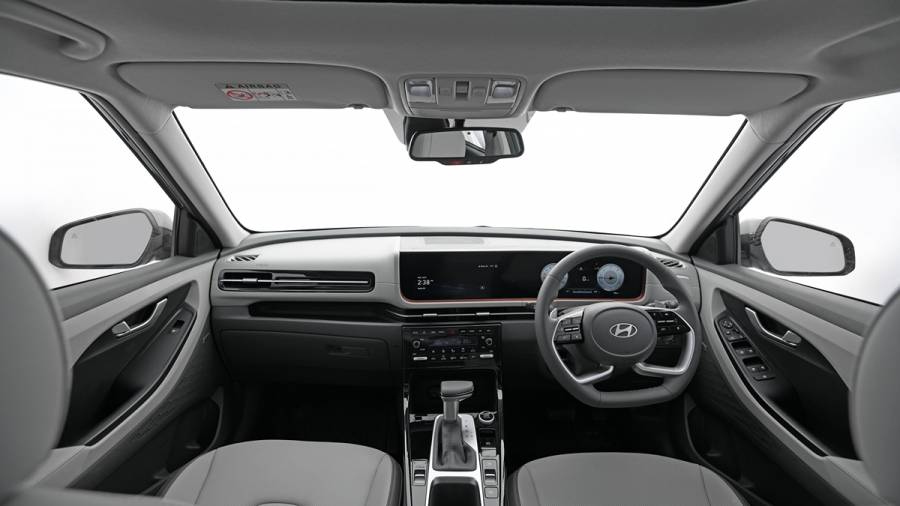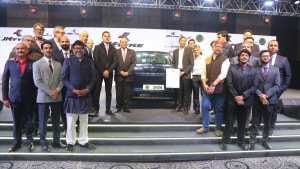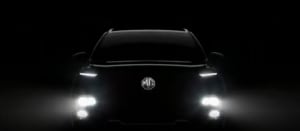Honda Elevate vs Volkswagen Taigun vs Hyundai Creta comparison - Middleweight Affair
We're no strangers to the Volkswagen Taigun and Hyundai Creta. The German has been around for over two years now and while the Korean in its latest avatar has only been around for 8 odd months, we've driven it quite extensively on multiple occasions. This time around though, we wanted to see how these SUVs feel in their lower state of tune. So we've ditched the 1.5-litre turbos and instead opted for the 1.5-litre NA Petrol Creta and the 1.0-litre turbo Petrol Taigun. One of the main reasons for this bold decision was that the Honda Elevate showed up at our doors and we were curious to see how it would stand out in this overcrowded SUV space. Offered strictly with a 1.5-litre NA Petrol powertrain, it almost seemed like the weather was seducing us to take the 3 cars and put them in a head-to-head battle. So we went out and did just what needed to be done.

Honda Elevate vs Volkswagen Taigun vs Hyundai Creta: Design
Looks are something that is in high regard with these new-age SUVs and in that regard, the 3 cars here are all worlds apart from each other. All these vehicles we have here have taken different paths in terms of their design language. For instance, the Hyundai Creta looks like the most upmarket of the lot with its gaping grille and massive stance, the Volkswagen Taigun has opted for a more timeless persona that undoubtedly makes it look the sportiest of the pack, even more so in this red shade. The Honda Elevate takes a different route and aims to stand out from the crowd with its boxy-looking fascia, which looks quite bodacious in my opinion.


The Creta is easily the biggest in terms of length, with the Elevate coming in as a close runner-up with just 18mm being the difference. The Taigun on the other hand is much smaller. It's about 91mm smaller than its Honda counterpart and a whole 109mm smaller than the Hyundai. The Creta is the overall bigger car but that doesn't translate for a win in the wheelbase. Infact out of the three, it is the shortest at 2,610mm. The other two SUVs are marginally ahead of it at 2,650mm.

Being a Volkswagen, the audience always wanted the Tiagun to look athletic and the Germans did deliver in that aspect. Honestly, if it were any bigger, like its competitors, anyone would've mistaken it for its older sibling, the Tiguan. The jolly face and the grille that looks like it runs straight into the DRLs make this the SUV to turn and look at twice.

I'm not the biggest fan of chrome detailing on a car but in this case, I don't mind it as it isn't overkill. The rear is where you would actually notice the smaller silhouette of the Taigun as it looks more crossover than an SUV. The full-width taillight at the back is something that owners would take some time getting used to, but I really do wish VW gets rid of the chrome around the 'what would've been exhaust pipe' area.


Personally, I've always believed that the Creta's stance was one of the biggest reasons for its huge success and with this facelifted model, Hyundai has definitely gone one step further. The oversized grille that floats into the sharp H-pattern full-width lighting makes the whole face look like an idol that Hyundai worships at their headquarters.

The placement of the headlights makes the Creta the only one that doesn't have fog lamps. In profile, the Korean looks pretty huge and that's something that has been consistent over the generations and works wonders. Better still is the rear, where the full-width lighting creates a 3D illusion and the redesigned boot lid replicates the sleek appearance from the front.

Honda has placed big bets on the Elevate and in all fairness, it delivers. At least from an onlooker's perspective, for now. The Elevate means business from all directions. It takes a step outside the book of what Honda did with the City and appears more imposing while also delivering on the sophistication aspect. The big grille is just partially open to feed air to the engine which isn't something I'm most fond of but the headlights look super neat and the creases in the bonnet make for good muscles around the edges.


The profile of the car is also well-crafted with old-school lines that remind you this is still a Honda and the design will age pretty well. Also, like I said it steps out of a crowd, at the back it also doesn't showcase a full light bar which is something out of the ordinary for 2024 at least. The rear end though does look very appealingly calm compared to the Creta and Taigun. The Elevate also offers the biggest boot space at 458 litres, with Hyundai running a close second at 433 litres while the VW sits in third with just 385 litres.
The Elevate and Creta have slightly more squarish wheel arches but the Taigun has circular ones that give it a more hunkered-down look. Talking about wheels all three cars here have a set of 17-inch alloys but it is the Creta's shoes that excite me the most.
Honda Elevate vs Volkswagen Taigun vs Hyundai Creta: Interior

Hop into the Cabin of these mid-size SUVs and it's the Creta's light colours and wrap-around dash that feels the most welcoming. The Elevate takes most of the points in terms of quality as the use of materials feels like it will be the one that will age really well. A typical Honda trait. The VW on the other hand continues with the slightly more sporty appeal that it has on the outside, over on the inside with everything a bit more angled towards the driver.


The Taigun's 10.25-inch touchscreen infotainment is definitely the easiest to use on the go. You wouldn't find yourself reaching out too much from your seat which is something that can't be said about the Creta's similar-sized touchscreen. The Creta pulls one over though as it feels like the best screen in terms of graphics and appearance. It sits flush with the digital cluster so you don't have to take your eyes off the road too much. The Elevate's infotainment is a bit of a mixed bag because while it is a big step up from what Honda does with the City sedan, it isn't on par with the two cars it's competing here against. The screen sits on top of the dash and the touch feedback is far from perfect. All cars have nice-looking digital clusters but I'm going to have to give the Honda points in this area because of the no complex and simple read-out of necessary information.



All cars are pretty evenly matched when it comes to the rear seats but since I have to nitpick, the Elevate takes the edge here because of the big shape and big windows. The Creta is the only one here with a panoramic sunroof so that makes for a better rear-seat experience.
Honda Elevate vs Volkswagen Taigun vs Hyundai Creta: Features
Common features include LED lighting, auto headlamps, climate control, cruise control, wireless Android Auto & Apple CarPlay (wired in Creta), powered outer mirrors, rear AC vents and push-button start. All cars have a wireless phone charger but the Creta has a total of 3 Type-C charging ports (1 front & 2 rear) while the Taigun takes that up a notch with a total of 4 (2 front & 2 rear). The Taigun is the only one to also offer powered front seats for driver and passenger whereas the Creta only offers it on the driver's side. The Elevate keeps things old-school with 2 USB-A ports upfront and manually adjustable seats.

Honda Elevate vs Volkswagen Taigun vs Hyundai Creta: Driving
The Taigun although just a 1.0-litre unit feels the most hurried of the lot. The engine begs you to put your foot down a wee bit more than you are because once past the 2,5000rpm mark, you feel like it really hooks on. The Creta's 1.5-litre naturally aspirated unit has its power spread out more unbiasedly across the band and there doesn't appear to be too much sense of urgency upon lift-off. Yes, once you get nearer to the mid-range the car does figure out the obvious and picks up the pace drastically.

Honda's proven 1.5-litre i-VTEC this time in an SUV form does a pretty good job in the Elevate. With 121PS, it is the most powerful on paper, but does feel a bit lazy in the lower revs. You would really have to squeeze the tap while making overtakes but once it finds its stride, it moves along pretty smartly.

The Elevate's CVT quite a bit before selecting the next gear ratio. It's alright for stop-and-go traffic but out on the highway while making overtakes it does get slightly annoying. The Creta's automatic feels the smoothest of the lot. Its changes are much less evident and you wouldn't find yourself lost in the middle of traffic while the gearbox figures out itself. The Taigun sits somewhere between these 2. Yes, it is a bit jerky while getting off the mark but out on the highway it does outperform itself even though it enjoys sitting in the higher revs.

The Taigun is a confident long-distance cruiser that is both comfortable and relatively well-damped on rough roads. The Taigun maintains its level ride even during sharp turns because of its excellent control over body roll, so you never feel like your comfort level has been compromised. Driving the Elevate over severe ruts and bumps, the suspension is remarkably quiet and provides an incredibly smooth ride. When you get to the curvy roads, the handling dynamics of neither the Elevate nor Creta can match the Taigun though. The Elevate will get you around but the Taigun will be the one to put a smile on your face. The Creta feels the most sturdy and planted while cruising though and it also handles larger potholes and broken patches a mere bit better than the other two.

Honda Elevate vs Volkswagen Taigun vs Hyundai Creta: Verdict
The Honda Elevate comes out of this competition as the most affordable car and by quite some margin. At Rs 19.73 lakh (on-road), it definitely is great value for money and that big 'H' up font will only complement this car in the years to come. But as of now, the Elevate still yearns for more. More of what the other two SUVs at this test bring to the table. The Taigun sits at Rs 21.08 lakh (on-road) and is the car that I was most excited to drive every time I had to pick up the VW keys. The engine feels enthusiastic and the ride quality is top-notch. I might even say it's almost perfect. Just almost though. The boot is slightly on the compromised side and the looks are already starting to remind me that yes this is the oldest car here.

This is where the Korean scores big. It is the most expensive car here as tested but for Rs 1.28 lakh more than the Taigun, it is the most complete SUV in this mid-size space. The 1.5 NA is very refined and paired with the automatic transmission it is pretty efficient as well. The Creta is loaded with features and tech, more than any other car in this segment and is big on space. Yes, the Volkswagen Taigun and Honda Elevate have their traits but as an overall package, I'm giving this one to the Hyundai Creta.
Starts Rs 10.5 Lakhs
1498cc
Automatic
115
250
17.88 Kmpl
Starts Rs 9.99 Lakhs
1353cc
Automatic
115
242
-NA-













